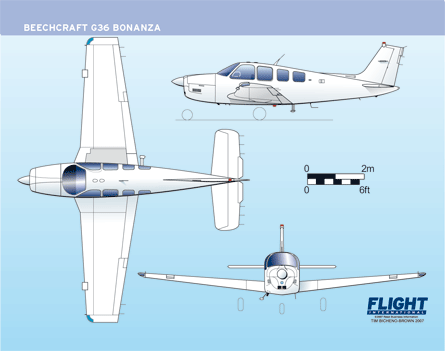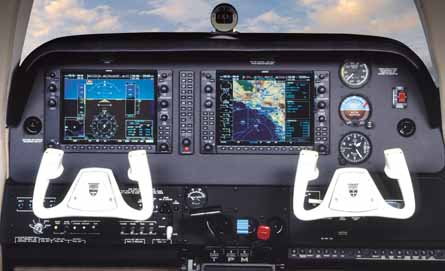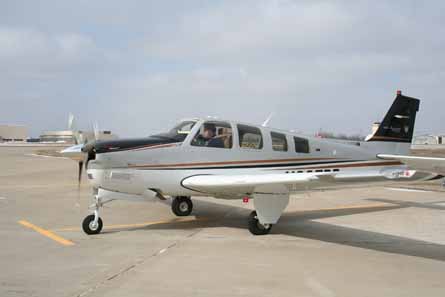In production since 1947, the Beechcraft Bonanza has been steadily evolving. The latest version, with new flightdeck and autopilot, offers surprising capabilities
Hawker Beechcraft may be a brand-new company, but it is celebrating 60 years of building the Bonanza piston single - a milestone no other aircraft has achieved. Since its initial type certification on 25 March 1947, more than 18,000 Bonanzas have been delivered and the latest G36 model brings the iconic aircraft into the 21st century with a Garmin G1000 integrated flightdeck, smoother engine and updated interior.
|
|---|
The G1000 is a highly capable system that offers features unheard of in GA until several years ago |
Throughout its 60-year production run many facets of the Bonanza have been updated. The original A336 was powered by a 165hp (125kW) six-cylinder Continental E-165, which gave the four-seater a top speed of 160kt (295km/h). The six-seat G36 has a 300hp six-cylinder Teledyne Continental IO-550B Special Edition, mass balanced for smoother operation at all RPMs. Turning a three-bladed metal 2.03m (6.66ft)-diameter Hartzell constant-speed propeller, this engine gives the G36 a maximum speed of 174kt.
Full-fuel payload
The same basic engine is used in the Bonanza's closest competitor, the Cirrus SR22. Rated at 310hp in the normally aspirated SR22, the IO-550 gives the four-seater a cruise speed of 185kt. The smaller, less-expensive SR22 has a full-fuel payload of 301kg (664lb), while the G36 has a full- fuel payload of 303kg.
While the newer SR22 is slicker, and even with fixed gear goes faster than the G36, it seats only four. With the ability to seat six and a sizeable internal baggage capacity, the G36 offers payload flexibility and Beechcraft's reputation for quality. For years the Bonanza has represented the gold standard in piston-powered general aviation aircraft.
|
|---|
While composites use in GA aircraft continues to increase, a well-designed conventional aluminium structure can be just as efficient. While most GA aircraft are certified in the normal category, with a +3.8g load-factor limit, the G36 is a utility-category aircraft with dual wing spars and a maximum g limitation of +4.4. The 154kt landing-gear and flap maximum extension speeds are yet another indication of the Bonanza's robust airframe.
While the sturdy airframe is relatively unchanged in the evolution from A36 to G36, the instrument panel has undergone a radical upgrade with the introduction of a Garmin G1000 integrated avionics system. This flat-panel display suite is offered on a variety of piston GA aircraft ranging from Cessna's 182 Skylane to its Citation Mustang very light jet. In the G36 the G1000 provides two 10.4in (26.4cm) liquid-crystal displays and is fully integrated with a Garmin GFC 700 autopilot.
The G1000 offers features unheard of in GA until several years ago. The two screens are typically configured as a primary flight display (PFD) and multifunction display (MFD). Either can display all required information in a back-up mode should the other screen fail. Dual-integrated radio units provide instrument flight rules-approved GPS and instrument landing system navigation and approach capabilities. A Honeywell KN 63 DME is available as an option. Dual VHF comm radios have 8.33kHz channel spacing.
Traffic information
A Mode S transponder is also standard, as is a traffic information system (TIS). This uses Mode S to uplink traffic information from ground radar sites. Opposing traffic is displayed on the MFD's map display, but conflict resolution guidance is not available. L-3's Skywatch traffic advisory system is available as an option, and is similar to TCAS as it displays nearby transponder-equipped aircraft.
A terrain awareness and warning system is standard, terrain and obstacles being displayed on the MFD's map display and also in an inset window on the primary flight display. XM WX satellite datalink weather capability is built into the G1000 avionics suite, its availability and use subject to a subscription fee. XM Satellite digital radio is also available on a subscription basis.
On a cold wintery Kansas day Flight International was able to fly Hawker Beechcraft's glass-panelled Bonanza. Demonstration pilot Justin White conducted the pre-flight inspection of the 60th Anniversary Limited Edition Bonanza on the ramp at Beech Field. The test aircraft sported the two most popular options for new Bonanzas: an air conditioner and heated propeller. The air conditioner is primarily used on the ground, and was not needed on the -2ºC (28.4ºF) day. To heat the propeller, thermostatic strips are placed near the root of each of the three blades. Unlike its twin-engined Baron sibling, the Bonanza is not certificated for flight in icing conditions. The hot prop is seen as safety net, allowing a measured departure from an unintended icing encounter.

While still on the ramp I sampled the club four seats in the aft cabin. The 1.14m (3.7ft)-wide double-entry doors allowed ready access to the passenger compartment. Six large windows made the cabin feel open and airy. Subjectively, the cabin felt roomier than that of the larger Eclipse 500 very light jet, whose window size is constrained by the demands of pressurisation. Entry into the cockpit was through the overwing pilot's door on the right hand side of the aircraft. The leather seat moves fore-aft adjustment, but has no height adjustment. Head room was good for my moderate height, but my head did brush the moveable sun visor when it was stowed against the ceiling.
The instrument panel is neatly arranged with the two displays mounted side by side. Conventional standby instruments are located on the far right-hand side of the instrument panel. While the likelihood of a dual display failure is quite remote, I would have preferred them in a more central location. Below the displays, the cockpit is standard Bonanza.
With the two batteries switched on before engine start, only the left display was available. In a compacted mode, it showed PFD information as well as engine data. Once primed, the fuel-injected engine fired immediately after the starter was engaged. After setting an idle RPM of 1,000 and switching on the avionics masters, I familiarised myself with the G1000 avionics.
A round-robin flight plan was selected and activated from one of the several stored in the G1000. As I found in the Skylane, manual entry of a flight plan can be tedious using the cursor knob and entry button. Perhaps one day Garmin will allow flight plan entry from a personal digital assistant via the infrared receiver on each display. The full-screen horizon line on the attitude director portion of the PFD was bracketed by tape-type airspeed and altitude displays. Directly above are autopilot and flight director mode status annunciators. Navigation and communication radio frequencies are also displayed along the top of the display. Twelve soft keys on the bottom of the display offer access to menu pages for system and display control. On the PFD I particularly liked the 2in x 2in inset window that can show traffic, weather, terrain, obstacles and other crew-alerting information.
Altitude selector
The right screen was configured as an MFD with a large map display as well as engine instruments and monitoring information. The autopilot control panel is located along the left-hand edge of the MFD bezel. The altitude select knob at the bottom of the panel is composed of an outer and inner ring, setting thousands and hundreds of feet. I found the two-knob system to be less intuitive than the single-knob altitude selectors found on most transport-category aircraft.
During the taxi to runway 36 I monitored our position on the airfield in the PFD map window, which can be set to a scale as large as 500ft. Propeller RPM was 2,700 and 28.2in manifold pressure attained for the take-off roll. I was surprised by how little right rudder pedal pressure was required to counteract the propeller-induced yawing and maintain centreline. On a standard day and maximum take-off weight of 1,656kg (3,650lb) a ground roll of 296m is listed, and was approximated by our actual ground roll. I rotated the aircraft at 72kt indicated airspeed and followed the flight director's "V" command bar to hold heading and climb at 700ft/min (3.55m/s). Gear retraction time was less than 5s, and minor pitch force changes due to flap retraction were easily compensated with electric trim. One neat feature of the G1000 is the transponder turning on automatically at lift-off and off on touchdown.
The turn out of traffic and initial climb to 6,500ft were hand-flown, allowing me to evaluate the Bonanza's control harmony. Subjectively I found roll and pitch forces to be well balanced. Sky conditions for the flight were broken clouds, and once above the cloud tops bright sunlight prevailed. The LCD screens were easily read in direct sunlight. Proper rudder application to maintain co-ordinated flight as airspeed varied was helped by referencing the slip indicator below the triangular bank indicator. As in the Skylane, I found the G1000's long horizon line a great aid for maintaining wings-level flight.
Once level at 6,500ft I engaged the autopilot, clearly annunciated above the attitude director indicator portion of the PFD. Shortly after level-off the TIS pointed out several conflicting targets along our route of flight. With the traffic's relative position presented on the MFD we were able to quickly gain and maintain visual contact in the visual flight rules environment. To approximate long-range cruise 23in manifold pressure and 2,300RPM were set, the Bonanza maintaining 156kt indicated and 169kt true airspeed.
I used the soft keys on the bottom of the MFD to select the engine-management lean page. Both cylinder head temperature and exhaust gas temperature are presented, but the latter is used for the most fuel efficient flow. Range rings on the MFD showed available cruise range both with and without reserve based on current ground speed. The rings expanded and contracted as fuel flow was adjusted to its optimum. Beechcraft lists a maximum-range speed of 149kt true airspeed and range of 1,650km (890nm) with four occupants at 8,000ft pressure altitude and with a 45min reserve. At these same conditions a maximum-speed cruise is listed at 174kt and yields a range of 1,230km. During the cruise portion of the flight, cabin noise was louder than a jet, but noise cancelling headsets provided a comfortable environment.
While still at 6,500ft the autopilot was disengaged to get a feel for the Bonanza's slow-speed handling characteristics. With the propeller control set full forward, manifold pressure was adjusted to maintain 75kt indicated. Approximately a quarter of the available right rudder was required to maintain co-ordinated straight-and-level flight. A series of 30º-bank turns were conducted, which showed roll and yaw control forces to be well harmonised. Next the wings were levelled and 14.3in manifold pressure set in preparation for a clean configuration stall. Slowing at about 1kt/s, an audible stall warning sounded at 71kt. Further slowing produced a mild wing rock that was successfully counteracted with both ailerons and rudder. At 65kt there was a noticeable g break. Relaxing aft yoke pressure and advancing the throttle recovered the aircraft from the stall.
ILS approach
With slow-speed manoeuvring complete the autopilot was engaged for transit to Newton, Kansas, where an ILS approach would be conducted. The ILS17 was selected and activated. An intercept leg to the initial approach fix of HARVS was selected, joining the published procedure between the feeder fix of STONS and HARVS.
The heading lateral mode of the autopilot was used to position the aircraft on an intercept heading for leg capture. The MFD's map provided a good overall view of our position relative to the desired ground track, but one bit of useful information was missing, a heading bezel. While a correct heading could be divined by referencing both the PFD and MFD, having a heading bezel on the map would have allowed for more intuitive operation. Using the vertical speed mode of the autopilot, a descent to 3,200ft was initiated. Vertical speed was controlled by pitch alone, the pilot selecting the desired rate by pressing the "up" or "down" buttons on the autopilot control panel.
Inbound to HARVS in navigation mode the autopilot automatically turned and tracked outbound from the initial approach fix for the procedure turn. The 45º offset turn to fly the "barb" was flown in heading mode as the system will not automatically fly the entire procedure turn. A left-hand 180º turn was completed to establish an intercept heading to the localiser. The Garmin avionics automatically identified the localiser, presenting its "ICAC" identifier letters in the upper left-hand portion of the PFD. Approach mode was armed, and the autopilot smoothly captured and tracked inbound on the localiser.
Before the glideslope intercept the landing gear was lowered and flaps set to approach. The throttle was adjusted to maintain 100kt. The autopilot accurately tracked both the localiser and glideslope. One omission in the G1000 avionics system became obvious approaching the published decision altitude of 1,730ft. The system lacks the ability to set an altitude "bug" independent of the autopilot/flight director system, and altitudes for the autopilot and flight director to display and capture are limited to increments of 100ft. At decision altitude the autopilot was clicked off and a climb to 1,000ft initiated. During the climb the gear and flaps were retracted. Once level, a turn to a visual left downwind for runway 35 was entered, as surface winds were 10-15kt out of the north-west.
On downwind, abeam the end of the runway, I lowered the landing gear and extended the flaps to approach. Base turn was started when the runway end was 45º past the wing line and an idle power descent initiated. The short power-on final approach was flown at flaps full and 90kt. Approaching the end of the runway the throttle was retarded to idle. The flare manoeuvre was initiated several feet above the runway and pitch attitude gradually increased until the Bonanza gently settled on the runway at 80kt.
During the roll-out the trim was reset and flaps retracted to approach for the touch and go. Right rudder was required as full throttle was applied for the go portion. Two more visual approaches to touch-and-go landings were flown to Newton's runway 35. During these manoeuvres I again found the Bonanza's flight controls to be well harmonised. Engine power was responsive and easy to modulate, allowing for accurate airspeed control. While the Bonanza is a capable aircraft, it is still a piston and should be more forgiving in the landing pattern than more complicated multi-engine aircraft.
Situational awareness
Return to Beech Field was at 3,000ft, again with the autopilot engaged. The RNAV GPS approach runway 18 to Beech Field was selected and activated. A direct course to DOLBE, a point outside the final approach fix of TOBEE, was selected and flown in lateral navigation mode. The autopilot accurately tracked the approach, while the MFD's map display greatly improved situational awareness. The aircraft was configured with gear down and flaps set to approach before the final approach fix.
At TOBEE I used the vertical speed mode to start down to the minimum descent altitude of 1,760ft. Passing 2,000ft (600ft above ground level), the autopilot was clicked off and a visual downwind for runway 36 entered, the winds still 10-15kt out of the north-west.
Again I found the Bonanza easy to handle in the traffic pattern. The full-stop landing was even smoother than those at Newton, no doubt due to my increasing experience. Once slowed to taxi speed, the Bonanza's nosewheel steering allowed accurate tracking of taxiway centrelines. Back on the factory ramp, shutdown and post-flight procedures were easily accomplished.
Flight time was 1h 4min, with a relatively long block time of 1h 38min due to my pre-take-off familiarisation with the G1000 avionics. While the migration of glass cockpits downward from transport-category to GA aircraft offers the potential for the greatest safety enhancement in years, it is imperative the pilot thoroughly knows the integrated avionics and remembers that "see and avoid" and "dead reckoning" are not merely catchphrases.
In continuous production since 1947, the Bonanza has evolved into a capable personal transport, the large cabin and ability to seat six giving it operational flexibility. The G36 is the latest and most polished Bonanza, the Garmin G1000 flightdeck and GFC700 autopilot offering surprising capabilities. The Bonanza has earned a loyal following over the years, and the updated G36 seems well-placed to continue that tradition.
Source: Flight International

























